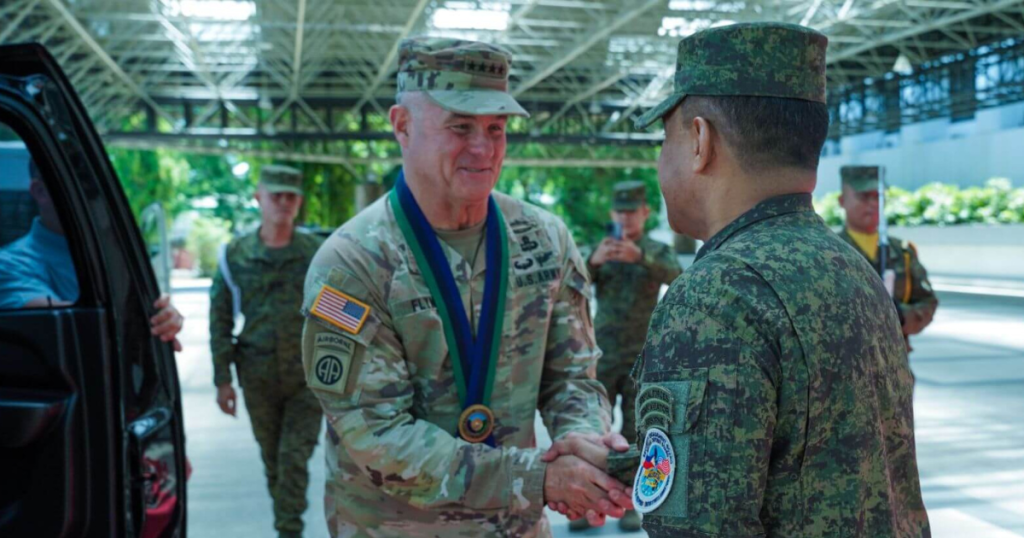Philippines, United States hold
second phase of Salaknib drills
General Brawner Jr., CSAFP, welcomes General Flynn, Commanding General of the US Army Pacific, during the latter’s office call on April 30, 2024. Photo from the Armed Forces of the Philippines.
By Manuel Mogato | Date 05-31-2024
Manila — The United States Army in the Pacific and the Philippine Army’s 7th and 5th Divisions will begin the second phase of the Army-led Salaknib exercises next month, testing for the first time the US Joint Pacific Multinational Training Center in the Indo-Pacific region.
More than 1,500 US Army personnel will take part in the two-week jungle training in Fort Magsaysay in Nueva Ecija, an Army colonel familiar with the exercise preparations said.
“The second phase is a 10-day drill from June 1 in Fort Magsaysay where the US and the Philippines armies will test their readiness to address an external threat,” an Army colonel said.
“But, what makes it special, is the whole drill will be monitored by sensors and a computer will assess how the two armies had done the maneuvers. This is state-of-the-art training that we have never experienced before. It has never been done before in the Indo-Pacific area, although it was tested on a limited scale in Australia last year.”
The first phase of Salaknib was held before Balikatan in the northern Luzon area, testing the US Army’s air and maritime capabilities.
This time, the US Army will test its ground forces in a purely tropical terrain and climate with the 7th Infantry Division in Fort Magsaysay, the Army colonel said.
The army colonel said it took over a month for the US Army to set up and build a training center in Fort Magsaysay and for sensor towers to be installed in the mountains and jungles in Nueva Ecija during the first phase of Salaknib in April before the three-week Balikatan started.
During the first phase of Salaknib, the US Army’s multi-domain task force shipped to the Philippines its medium-range missile launcher Typhoon to test how fast and effective it could deploy such equipment. The US Army also moved the missile launcher around northern Luzon and was in Laoag for the Balikatan exercise.
“It was never fired but it was in the area when the US and Philippines held a sinking exercise off the Ilocos Norte coastline,” the army colonel said.
“I think what the US did was test how the medium-range missile launcher would work under hot and humid tropical conditions. Remember that the Typhoon was based in a cooler climate in the US and would be perfectly the same conditions in Japan. But the Philippines has hotter weather and the equipment stayed near the ocean. I guess the US Army also wanted to find out if the seawater affected the equipment. It was a learning experience for the Americans.”
The Army colonel said he has information the Typhoon system remained in the Philippines even after the end of Salaknib and probably until July when the US Army planned to move it elsewhere for another exercise.
“But, it will definitely be back in the Philippines next year when we will hold another Balikatan and Salaknib exercises. It will become a regular feature in the Army exercises as the US is expanding its engagement in Southeast Asia.”
For a long time, the US has larger Air Force and Navy presence in the Philippines and other Southeast Asia, like Singapore. The US Army has an active presence in Japan, South Korea, and Thailand. However, the US Army realized many Southeast Asian states, like the Philippines, Indonesia, and Thailand have bigger land force components.
The US Army also observed the Philippine Army is still transitioning from mainly a counter-insurgency force into territorial ground forces.
“The US Army saw an opportunity for bigger training opportunities because we lack capacity and capability,” he added.
The US Army has started to set up a training center in Fort Magsaysay, one of the EDCA sites, and to allow Washington to spend millions to improve the training facilities for infantry and special forces, upgrade an airfield and helicopter landing sites, and build a better logistics hub where the US military can pre-positioned supplies and equipment.
The Philippines will be the first site of the Joint Pacific Multinational Combat Training Center in the Indo-Pacfic area.
“It would enhance and upgrade our skills and capability as a world-class army unit,” he added.

